Causes of high food prices
This report is about the causes of high food prices, focusing on staple grains
This report is about the causes of high food prices, focusing on staple grains
This report focuses on three major river basins in South Asia: the Ganges-Brahmaputra-Meghna, the Indus and the Helmand.
This study attempts to empirically investigate the implications of unshackling of the global textile trade, following the complete phasing out of the Multi-Fibre Agreement (MFA) in 2005, on the efficiency of firms operating in the Indian textiles industry.
The Asia-Pacific Fishery Commission (APFIC) is committed to acting as a regional consultative forum, providing its member countries, regional organizations and fisheries professionals in the region with the opportunity to review, discuss and decide on actions and challenges facing the region
This paper utilizes two different approaches to assess the impact of significantly scaling up investment in public agricultural research in developing countries in general, and in the CGIAR in particular. First, it models the potential impact of doubling research investment on agricultural (food) production and poverty reduction, and also on international food prices.
This report presents an assessment of progress of European countries towards achieving the objectives of the UN Framework Convention on Climate Change (UNFCCC) and their emission targets under the Kyoto Protocol.
Genebanks are one of the world
This brief examines policy options for addressing competitiveness concerns arising from the establishment of a mandatory domestic program to limit greenhouse gas emissions. These concerns center on energy-intensive industries that compete globally and could face higher costs under a domestic climate program while key competitors do not.
As well as providing crucial support in Africa, the new policy will help 30 million people in South Asia to gain access to sanitation. Half the population of the developing world still lives without basic sanitation, while almost 900 million people go without safe and reliable water supplies.
This study illustrates a methodology to assess economic impacts of climate change at city scale, focusing on sea level rise and storm surge. It is based on a statistical analysis of past storm surges in the studied city, matched to a geographical-information analysis of the population and asset exposure in the city, for various sea levels and storm surge characteristics.
The Clean Development Mechanism (CDM) under the Kyoto Protocol to United Nations Framework Convention on Climate Change (UNFCCC) provides an opportunity for the Indian power sector to earn revenue through the reduction of greenhouse gas emissions (GHG),

This short book analyzes the prospect of large-scale forced migration as a result of climate change and attempts to estimate the developmental impact of potentially millions of people displaced by coastal flooding, extreme weather events and agricultural disruption.

This paper, a companion to Transport for Development, proposes a different approach
Global health has in recent years drawn increasing scientific, political and popular attention not only due to global epidemics themselves,but also because of the social activities and environmental conditions that shape health threats and influence those who are affected.
This report summarizes the results of a global study on the development and present status of shrimp fisheries, with a focus on direct and indirect social, economic and environmental impacts. The study reviews the current situation, problems and issues, as well as the solutions found and the trade-offs made.
This publication captures some of the key knowledge and shared learning from an international policy dialogue on the
Current day concentrations of ground level ozone (O3) are commonly reducing crop yields by between 5 and 35 % at agriculturally important locations across South Asia. O3 induced economic crop losses could be in the region of $4 billion per annum for staple crops in South Asia; such losses are likely to impact more on poor and vulnerable people.
For the urban poor in developing countries, informal waste recycling is a common way to earn income. There are few reliable

Since the United States
This brief outlines the motivation for and key features of a tax designed to reduce emissions of greenhouse gases (GHGs). The two most commonly discussed market-based instruments for reducing GHG emissions are a cap-and trade system and a GHG (carbon) tax. These mechanisms function in a similar way by establishing a price for GHG emissions.